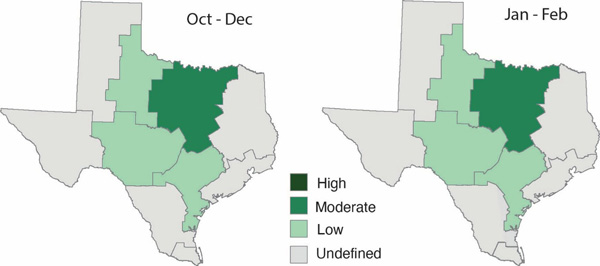Over the last ten years, stripe rust has been one of the most damaging wheat diseases in Kansas. There are several factors that contribute to the development and severity of stripe rust in our region within a given year. The stripe rust pathogen typically does not survive in Kansas over the winter but can survive in Texas through the winter months and make its way back north as the weather warms in the spring. Because of this, weather conditions in Texas can be important indicators of how bad stripe rust will be in Kansas.
We have received reports that low levels of stripe and leaf rust were active in College Station, TX, and Waco, TX, in late February. As of today’s publication, we have not received any reports of stripe rust in Oklahoma or Kansas. Historically, stripe rust detections in Kansas prior to April 15 have been associated with bad stripe rust years. Scouting efforts over the next few weeks will be very important.

Figure 1. K-State research has shown that the annual severity of stripe rust outbreaks in Kansas can be predicted by soil moisture in key regions of Texas in both the fall and the early spring. In 2024, soil moisture in Texas was low to moderate (indicated by medium/dark green colors on the map). In the spring of 2025, moisture in key regions of Texas was also low. These maps show soil moisture levels based on the “Palmer Z-Index” provided by NOAA-National Centers for Environmental Information. Maps courtesy Erick DeWolf, K-State Research and Extension.
What is the outlook for Kansas wheat?
The maps above indicate that conditions this fall/winter were dry in parts of Texas that are important for stripe rust overwintering. At K-State, we combine this information with several weather-based models to help forecast whether or not stripe rust will be widespread and yield limiting in Kansas. Right now, all models are indicating that the stripe rust risk is generally low for this year. Historically, years that begin like this have ended with lower-than-average yield losses in Kansas to this disease.
Of course, stripe rust severity in Kansas is still driven by weather conditions in the state in the late spring. Once stripe rust is detected in Kansas, cool evenings and extended periods of canopy moisture will be necessary for disease establishment at levels that would result in yield losses.
The disease situation can change rapidly, and it is important to continue to scout for signs of disease development as the season progresses. We will continue to provide updates on stripe rust occurrence and weather outlook as we move toward critical growth stages for fungicide applications in Kansas over the next several weeks.
Please contact me (andersenk@ksu.edu) if you detect stripe rust in Kansas so we can update regional maps.
Kelsey Andersen Onofre, Extension Plant Pathologist
andersenk@ksu.edu
Erick DeWolf, Plant Pathologist
Tags: wheat disease stripe rust leaf rust